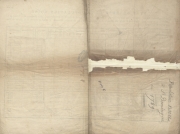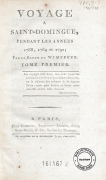bloc_article_content
Haiti’s independence debt. The slave as a unit of account (1794-1922)
In 1804 Haiti is declared independent by its formerly enslaved people of African origin. 21 years later, in 1825, France recognises the sovereignty of the former ‘French part of Saint-Domingue’ in return for compensation to be paid to the ex-property owning colonists. Haiti will struggle for a whole century to pay off this debt incurred by independence and the loans raised in connection with it.
The western part of the island of Hispaniola (c. 24,000 sq.km) had come under French control at the end of the 17th century. Some 80 years later, the colony was a major contributor to the surplus in the overseas trading activities of metropolitan France. The African men and women who had been deported in slave ships and enslaved in French Saint Domingue were key to these dynamics, and the colony rose to become a world-leader in sugar production. When the Revolution erupted in France in 1789, the conflicting demands running throughout the various social layers in the colony became more acute. There were armed clashes which led to the destruction of plantations and urban properties. These confrontations and a general uprising of slaves (from 1791) led to a first wave of departure among the owners. As in metropolitan France, once the monarchy had fallen, a number of properties which had been abandoned were sequestered and integrated into the henceforth designated ʻcolonial domainʼ.
The abolition of slavery (1794)
In the summer of 1793, in order to defend the colony’s borders against invading English and Spanish forces, the emancipation of more than 450,000 enslaved people was proclaimed forthwith. The newly freed men and women from Africa and Saint-Domingue came to the defence of the French republican flag alongside free people of colour (some 30,000 in 1789, a majority of them Mulattoes) and a number of white republican colonists (a tiny minority of the roughly 30,000 in 1789). The abolition of slavery, thenceforth extending to all French overseas territories, was ratified by the metropolitan government in 1794, without any provision for compensation to the slave-owners. In 1802, as a result of the Treaty of Basle [1795], the entirety of the island Hispaniola was under French control, a revolutionary war ensued upon the arrival of an expeditionary force sent by the First Consul to re-establish slavery. Bonaparte’s army was defeated by the insurgents and withdrew. On 1 January 1804 the population of Saint-Domingue declared independence and renamed the island Haiti. In inheriting the colonial domain of the former ‘French part of Saint-Domingue’, the newly born Haitian state took over the bulk of the properties which had been devastated by a decade of war. From then on ‘slavery is abolished for ever' and, essentially until 1918, ‘no white person’ can reside there as ‘a master or property owner’.
Independence not recognised
France under Napoleon and then the Restoration continued, however, to regard the new black state as a rebel colony. In the uncertainty, no other power established diplomatic relations with Haiti, even if some did maintain commercial ones. In 1814, in the course of exchanges with the emissaries of Louis XVIII, President Alexandre Pétion rejected any notion of a return to the colonial order. He did however concede the possibility of negotiating compensation for the former colonists, limited to their real estate losses, excluding slaves, who had been freed by a decision of the French state itself. Jean-Pierre Boyer, who was president of the entire island as of 1822, kept this possibility open while rejecting any form of French protectorate. 1824, however, marked an inflection point. Boyer adhered to the principle of recognition of Haiti’s sovereignty by a decree of the French king, Charles X, in exchange for financial compensation for this act of ‘benevolence’. Boyer’s other concessions (the sum to be paid in compensation, customs benefits etc.) were not deemed sufficient, and Charles X laid down burdensome territorial, fiscal and financial conditions in his Decree of 17 April, 1825 for recognition of the independence of the ‘French part of Saint-Domingue’. On 8 July of the same year, as a squadron approached, armed with 500 cannons and threatening to blockade Haiti’s ports should these demands not be met, President Boyer accepted the conditions laid down while requesting that they be reviewed. His undertaking was registered by the Senate on 11 July, in the name of – a high estimate – some 800,000 Haitians. Immediately after this, most other powers entered diplomatic relations with Haiti. The injunction that there should be compensation is at the heart of the royal decree of 1825.
Reparation for the former colonial property owners
The former colonists were therefore to be compensated for their losses in real estate, that is to say, their rural and urban properties, to a tenth of their 1789 value. The total indemnity to be settled amounted to 150 million francs, to be paid in five annual instalments. This was equivalent to 15% of the annual revenue of the French state at the time, but to at least ten times that of Haiti. The new republic tried in vain to have the debt reduced, but in order to honour the first instalment, it had to take out a loan in November, 1825 of 30 million francs on the French market. This loan was payable over 25 years, with an interest rate of 6%. Yet since Haiti only received 24 million of it once bank commissions had been deducted, it had to dig deep into public funds to be able to meet the deadline for the first payment on 31 December 1825, as laid down by the royal decree.
One-fifth of the reparations demanded of Haiti was to be received by the Caisse des dépôts et consignations (hereafter CDC) in France. A procedure also had to put be in place to identify the first beneficiaries and establish mechanisms for the distribution of the funds. A royal commission set up by Charles X on 1 September 1825 deliberated on this for three months. It recommended that the French state should itself make no demands in relation to its real estate in Saint Domingue, and that only former colonists, who had been landowners and had forfeited their possessions, should be entitled to request compensation. There were some exceptions, however, among which in particular, that such right, subject to conditions, should be kept open for coloured landowners who, having remained loyal to the French cause, could not therefore have retaken possession of their property in Haiti. Having established this framework, the commission had to work on a proposal for a series of bills to govern the redistribution of the indemnity while closely protecting the interests of ex-colonistsʼ creditors.[1]
The commission worked from the annual product of the colony in 1789 and the legislation of the time, basing this redistribution as well as property evaluations on proof of ownership and proper justification of its value. In two of the three methods of valuation proposed for processing the claims and establishing the value of a lost property, one tenth of which would constitute the compensation awarded, it could appear that the enslaved workforce was either not taken into account or was masked. This was the case for the method which was based on the purchase (as well as rental) value of a property, and for the one based on the annual product of a rural property. However, for the valuation of a rural plantation producing goods for export, the Code noir enforced in the French colonies in 1825 came into play and served as a common thread.
Freedom monetised
In Saint Domingue, in accordance with articles 44 and 48 of the Code noir, when a real estate transaction took place, the enslaved work-force represented between 30 and 60% of the value of a rural property (habitation), alongside the livestock, the buildings and the land. The same proportion of elements would therefore be included in the total amount awarded as compensation upon notarial proof of ownership. In this case, President Pétion’s primary demand that any indemnity for the loss of a slave be prohibited was totally ignored.
What is more, claims could be made on the basis of the number of slaves owned more that thirty years earlier, and usually in fact bought on credit. The commission effectively foresaw that claimants might not have documentation regarding the value of an estate and tried to find ways of remedying this. The slave being considered to be chattel (bien meuble) was key to circumventing the issue and served as the basis of the third proposed method of valuation. To assess this workforce in every realm of its activity, the commission chose to establish a market value based on a quantification of the overall volumes and values of the annual production of slave labour in Saint Domingue. This calculation fixed the market value of slaves at a higher rate than those current in Saint Domingue at the end of the 1780s. Prices ranged from 2,000 to 4,500 francs ‘per head’ depending on the occupation assigned to the enslaved person. The commission drew up a ‘per head’ scale of compensation for slaves in both the rural plantation and the urban sectors. In general terms, the ‘per head’ rate was equivalent to 10% of the price attributed to the slave in question. This cost-driven, slave-based method of evaluation was yet another way the ex-property-owning colonist could gain compensation.
The identification of direct and indirect beneficiaries of indemnification, and the three methods of property evaluation underpin the bill drafted by the royal commission of 1 September 1825. The text, together with an expert report, was laid before Charles X at the end of that year.
The Law of 30 April 1826 regarding distribution of the indemnity, incorporated the bulk of the French commission’s proposals. On 9 May, a royal decree that detailed the criteria for entitlement and for property evaluations was issued. Susceptible to adjustment, this dispositive was shortly adopted by a new ‘liquidation’ commission, tasked with determining the admissibility of claims and the sums to be allocated to the persons being compensated. Haiti having already paid to the CDC the first fifth of its ‘independence debt’, essentially thanks to the external loan which it had taken out, the process of indemnification got under way in France in the second half of 1826.
Sovereignty caught in a vice
From that very moment and for a whole decade, Haiti – insolvable – was doubly in default on payments due, both for the indemnities and for the loan. Finally, in 1838, France recognised Haiti’s independence, unconditionally this time. The total indemnity was renegotiated downwards (to 90 million francs), and its payment spread over 30 annual instalments. The proportion of the property value allocated to the ex-colonist was by the same token reduced by 40%. Not long after, discussions between the Haitian state and the bondholders of the 1825 loan were concluded: the interest rate was reduced to 3% and the reimbursement rescheduled. After many adjournments some 8,000 ex-colonists, or rather their heirs and assignees, will finally be indemnified.
Haiti was indeed committed to honouring the independence debt despite the falling price of coffee, grown by small peasant producers and the mainstay of the state’s revenues. Despite opposition to this tribute payment (i.e., rebellions among soldiers, street demonstrations etc.), the coercion imposed by the army, the severity of the Rural Code and the growth of internal debt allowed the authorities, more or less and barring certain exceptional events, to pay the sums due. Moreover, recognition by the French state of each successive Haitian government was conditioned upon the regularisation of annuity payments for the debt. New payment schedules were also adopted both for the indemnity (1847) and for the loan (1848 and 1854). If servicing the external debt siphoned off half the state’s revenues between 1838 and 1844, by 1870 it accounted for only 15%. That year, to consolidate settlement in view of the coming deadlines, the French legation negotiated an arrangement which rolled the payments for both obligations into a ‘double debt’.
The independence debt is finally paid off by Haiti in 1878 by way of a loan raised on the French market in 1875. The external loans of 1825 and 1875 are, respectively, paid off in 1887-88 and in 1921-22, at the beginning of the violent occupation of Haiti by the United States (1915-1934). These two reappropriations of government funds – which is to say, the taxes levied on the crops produced by Haiti’s small peasantry, the descendants of the emancipated slaves of 1794 – will last a whole century. The first is carried out to benefit both the ex-colonists (or their heirs) who had owned land and slaves, and their creditors; the second to benefit the banks and the bondholders involved. This imposed diversion of the financial resources of the young republic is, at its outset, in line with the national policy of Restoration France and with the global slaveholding and colonialist interests of the Atlantic world. It is also in line with the international economic order of the 19th century with which the rulers of Haiti had to contend. And finally, it has played a determining role in the long-term entrapment of Haiti in a spiral of debt and under-development.
1]G-K Gaillard-Pourchet, ‘La "dette de l’Indépendance". La liberté du genre humain monnayée (1791-1825) », IFJD, 2022.
Written in may 2022. Published in november 2023







